

一次搞懂!何時該說Sorry,何時該說Excuse me? (excuse me,sorry excuse me,excuse me sorry,excuse me?,excuseme,ex cuseme,excuse us,...) - 職場力 - 英文學習 - 戒掉爛英文. 我們的學生John上課時不小心把水打翻在外籍老師的筆記本上,情急之下,他順口說一句:Excuse me!

這句話一出口,他覺得又好像該說Sorry才對。 「到底是sorry還是excuse?」 John問,英文學了一、二十年,但經常在這種簡單的不得了的情境上破功。 英國語文學家 Michael Swan在他的名著《Practical English Usage》中細分Excuse me與Sorry。 Excuse me通常在說或做可能令人不悅的事情之前使用,有「事先告知」,事前請求別人允許的意味: "Excuse me" is asking for permission. 而Sorry在說或做這種事情之後使用,表示歉意;事後要求原諒: "Sorry" is asking for forgiveness. 美國人口語上使用Excuse的機率比sorry高很多,打擾別人用,吸引人注意時也用,來看幾個例子: 攀談時:Excuse me. A: "She is a good boss. " Sorry的使用時機,通常用在說話者: 「有不好的消息要告訴對方」 「幫不上忙」 「未達到對方期望」 「犯錯」 但如果後面加了一個but,其實是非道歉的道歉。 Excuse me和sorry在某些狀況下可以互用。 聽以下A、B兩人的對話實况,幫助記憶: A:It's the plumber at the door. B說的Sorry? Iva_Slezakova. Is.cuni. 4 Lesson Plans to Make Your CLIL Dreams a Reality. Like a long road trip, CLIL is one of those things that sounds magical from a distance.

That is, until you actually start to do it. Then reality sets in. With CLIL (Content and Language Integrated Learning), students learn various subjects like history, art, science and math in a foreign language. Rather than being a stand-alone subject, language becomes a skill acquired in the classroom while mastering other types of content. And truthfully, what is not to love about that? It makes language relevant and meaningful in a way that few other methods can, and it strengthens the connections among various content area subjects. Then you sit down to start planning a lesson and you have no idea where to even begin. Don’t worry! The Ingredients of a Great CLIL Lesson Before we actually begin the planning process, let’s think about what comprises a quality CLIL lesson. A clear progression of knowledge that meets the identified goals of the curriculum. How to Come Up with Ideas “Okay, okay,” you say. Using Blooms Taxonomy to Promote Critical Reading and Thinking Skills.
Coyle_clil_planningtool_kit. Using Blooms Taxonomy to Promote Critical Reading and Thinking Skills. Blooms%20Taxonomy%20questions.pdf. BLOOM'S TAXONOMY'S MODEL QUESTIONS AND KEY WORDS. BloomRevisedTaxonomy. Assessment - Blooms Taxonomy Action Verbs. 「せんたくかあちゃん」絵本読み聞かせ. 2 Understanding. 1 Remembering. Home. Stories ioannougeorgioudoloresramirez. Teaching critical thinking using Bloom’s Taxonomy. Published 18 April 2014 In her previous posts, Unlock author Carolyn Westbrook introduced the basics of teaching Critical Thinking in ELT.
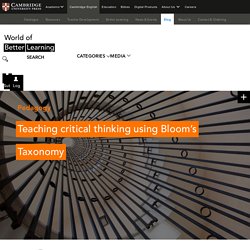
Today, she explores Bloom’s Taxonomy. Bloom’s Taxonomy of Learning Objectives classifies a number of skills which can be used to teach critical thinking. The six skills are often depicted as the triangle shows. However, representing the skills like this gives the impression of a hierarchical approach to critical thinking. This is not necessarily the case, however. CA Unit 1 Introduction.
Coyle clil planning. KEY PRINCIPLES - CLIL principles. CLIL principals consist of three main blocks: - the 4Cs: Content, Communication, Culture and Cognition.
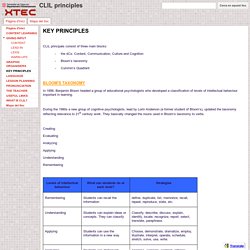
CLIL Glossary. What Bloom can do for you! A colleague of mine once said: CLIL is all about teaching students both higher language as well as higher thinking skills.

I agree. Yet, implementing that into our everyday lessons is a challenge for many of us. Or at least for me. So, in this post I want to talk about different thinking skills and how to apply them to your lesson. JoLaCE 2014 2 Hanesova. Hints11bloomtaxonomy. Games as instructional technology II: Bloom’s Taxonomy. Another pedagogical element present in games is Bloom’s Taxonmy.
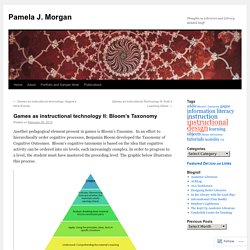
In an effort to hierarchically order cognitive processes, Benjamin Bloom developed the Taxonomy of Cognitive Outcomes. Bloom’s cognitive taxonomy is based on the idea that cognitive activity can be ordered into six levels, each increasingly complex. In order to progress to a level, the student must have mastered the preceding level. The graphic below illustrates this process. The application of this hierarchy is evident in games.
Works Consulted Becker, K. (2007). Dickey, M. Driscoll, M. 17 Best images about Interactive Whiteboard Games/Lessons on Pinterest. Interactive WhiteBoard Treasure Chest - Interactive Whiteboard Resource Treasure Chest. FREE TEMPLATES in PowerPoint format for Holidays, Education, and more. Even Steven and Odd Todd. Bloom wheel. Bloom's Taxonomy by radhika1105 - Teaching Resources. More Than English: Teaching Language & Content to ELLs. What is Bloom’s Taxonomy?
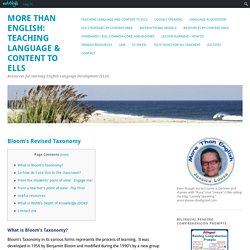
Bloom’s Taxonomy in its various forms represents the process of learning. It was developed in 1956 by Benjamin Bloom and modified during the 1990’s by a new group of cognitive psychologists, led by Lorin Anderson (a former student of Bloom’s) to make it relevant to the 21st century. The revised taxonomy emphasizes what a learner “Can Do” so the stages are now represented as verbs: We must remember a concept before we can understand it. We must understand a concept before we can apply it. So how do I use this in the classroom? We need to “teach to the highest and scaffold the lowest” students of all ages and levels of English proficiency.
Remember Understand Apply Analyze Evaluate Create Model what each means for your students in the context of a lesson. All 6313603. Bloom's Taxonomy Lesson Plans in the Classroom. Have you ever heard a student complain, "This question is so hard!
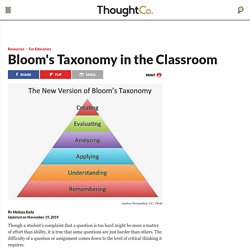
"? While this may be a common complaint, there are reasons that some questions are harder than others. The difficulty of a question or an assignment can be measured by the level of the critical thinking skill required. Simple skills such as identifying a state capital can be measured quickly. More sophisticated skills such as the construction of a hypothesis take much longer to be assessed. Thinking frameworks bloom. Blooms taxonomy chart. 05 2Bloom 18 Blooms Question Wheel. BloomWritingObjectives. BloomWritingObjectives. 03 Writing Lesson Plans Using Blooms Taxonomy.